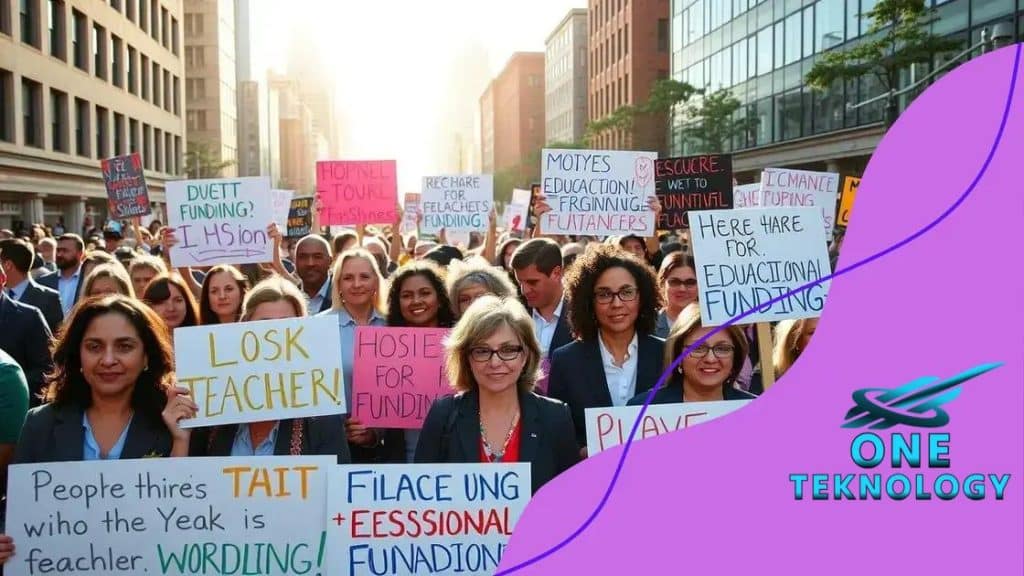NEA protests federal cuts to public education funding

Communities can play a crucial role in supporting education funding by organizing fundraising events and partnering with local businesses.
Additionally, attending school board meetings to advocate for change and fostering greater parent involvement are key strategies to secure better educational resources.
NEA protests against federal cuts to public education funding have ignited important national discussions.
As educators unite to protect essential resources, understanding the impact on both teachers and students is more important than ever.
Overview of NEA’s stance on funding cuts
The National Education Association (NEA) plays a crucial role in advocating for teachers and students, especially in the face of looming budget cuts.
Their stance on funding cuts highlights the significant impact these decisions have on public education.
Recently, the NEA has expressed strong disapproval of planned federal cuts to education funding.
They argue that this reduction not only affects teachers’ salaries but also compromises resources available to students. Ensuring every student has access to quality education is at the heart of NEA’s mission.
Key Concerns of the NEA
The NEA emphasizes several critical issues regarding funding cuts:
- The risk of larger class sizes
- Reduced access to vital programs and resources
- Increased stress for educators as they contend with fewer resources
- Long-term negative effects on student learning and achievement
These concerns resonate with many educators across the nation. The NEA believes that quality education should be a priority and not compromised by budget constraints.
They are mobilizing educators and communities to voice their dissatisfaction and push for better funding.
Advocacy and Mobilization Efforts
The NEA’s response includes extensive advocacy efforts aimed at influencing policy makers. They utilize various platforms to communicate the narrative that education is essential for every child.
By rallying teachers, parents, and communities, the NEA showcases the importance of standing against cuts that would harm public education.
With growing support, the NEA’s movement against funding cuts aims to unite individuals in the cause. The message is clear: every call for equitable funding strengthens the fight for better educational outcomes.
Impact of federal cuts on public education
The impact of federal cuts on public education is profound and far-reaching. Students and teachers alike feel the consequences of diminishing resources that are vital for effective learning.
One major effect of these funding cuts is the reduction in essential programs. Schools often have to choose between keeping valuable extracurricular activities or providing necessary academic resources.
This creates a challenging environment where opportunities for students dwindle, ultimately affecting their overall education.
Loss of Resources
When federal funds are cut, schools struggle to maintain quality educational resources. This can lead to:
- Larger class sizes, which reduces individual attention for students
- Fewer teachers and staff members, impacting student support
- Limited access to technology, hindering students’ learning experiences
- Cutbacks in essential programs such as special education or arts
These factors exacerbate existing challenges and can lead to a decline in student performance.
With less support, teachers face increased pressure to deliver quality education, often leading to burnout.
Effects on Student Outcomes
As federal funding decreases, the long-term effects on student outcomes become evident.
Many students may lag in essential skills, putting them at a disadvantage compared to peers in better-funded schools. This disparity creates a cycle that impacts future employment and success.
Moreover, the emotional toll on both students and educators can’t be overlooked. With increased uncertainty surrounding education funding, morale often suffers.
Teachers feel undervalued and unsupported, while students may feel their futures are being compromised.
Responses from teachers and educational leaders

The responses from teachers and educational leaders regarding the recent funding cuts are overwhelmingly concerned and proactive. Many educators feel that these cuts threaten the quality of education that students receive.
Teachers across the nation have come together to voice their opinions against the federal cuts impacting public education.
They argue that education should be a priority, not a victim of budget constraints. Communication has surged among educators, urging for unified action to influence policy decisions.
Collective Action
In light of these funding challenges, teachers are organizing rallies and writing petitions to bring awareness to the issue. Their collective efforts can be summarized in the following points:
- Holding community events to educate the public on funding issues
- Collaborating with local organizations to strengthen advocacy
- Encouraging parents to join the fight for better funding
- Using social media to spread their message and gain more support
Additionally, educational leaders are voicing their support, emphasizing the need for stable funding to provide adequate resources. They highlight that without proper investment, schools cannot meet students’ diverse needs.
Emphasizing Student Needs
Throughout their responses, teachers and educational leaders consistently express concerns about the impact on students.
The calls to action are not just for their benefit, but for the students’ future. They point out that when schools are deprived of necessary funds, it leads to:
- Increased inequity among different school districts
- Large class sizes that hinder personalized instruction
- Reduction in essential programs, such as arts and sports
- Higher teacher turnover rates due to job dissatisfaction
The hope among educators is that by raising awareness and demanding change, they can help safeguard the future of public education. They believe strong communities can pressure decision-makers to prioritize education funding.
Comparative analysis of funding changes over years
The comparative analysis of funding changes over the years reveals significant shifts that directly impact public education. Understanding these trends allows us to grasp how federal cuts influence schools and students today.
In past decades, funding for public education has seen both increases and decreases. Early on, federal investments in education aimed to improve access and quality.
However, this has not always been the case in recent years, as budget constraints have emerged as a critical issue.
Trends in Education Funding
Funding trends from the last decade show a concerning pattern:
- Between 2010 and 2015, many states increased their education budgets, aiming to improve outcomes.
- In contrast, federal funding has often lagged behind, leading to reliance on state and local sources.
- Recent years have seen cuts that disproportionately affect low-income school districts.
- Now, funding is often static, leaving many schools struggling to maintain basic resources.
These changes highlight a growing divide where some districts thrive due to stable funding, while others experience significant challenges. The impact is felt acutely among students who rely on public education for opportunities.
Long-Term Consequences
The long-term consequences of funding changes are profound. Students in underfunded schools often do not receive the same quality of education as their peers in better-funded areas. This can lead to:
- Lower graduation rates and decreased college readiness
- Widening achievement gaps among different socioeconomic groups
- Higher dropout rates and decreased community engagement
- Under-resourced schools struggling to provide essential programs
As we analyze these trends, it becomes evident that the need for stable, equitable funding is crucial for the health of public education.
This understanding helps inform advocacy efforts aimed at protecting educational resources for all students.
Future implications for public education policy
The future implications for public education policy are crucial as funding continues to fluctuate. There is a growing concern about how changes in funding will shape the educational landscape for future generations.
As the push for more equitable funding gains momentum, educational leaders are starting to envision policies that could stabilize and improve public education.
They recognize that without sustainable funding models, schools may struggle to meet the needs of their students.
Potential Policy Changes
Future policies might focus on addressing the inequities in education funding. Key areas of focus could include:
- Implementing state-level funding formulas that ensure resources are distributed equitably
- Establishing measures to protect against sudden funding cuts
- Encouraging community involvement in school funding decisions
- Increasing transparency in how education funds are allocated
These potential changes aim to create a more supportive environment for both students and teachers. By prioritizing equity, policymakers can help ensure that every student has access to quality education irrespective of their background.
Long-Term Vision
In addition to immediate reforms, there is a need for a long-term vision for public education. This vision could include:
- Investing in teacher training and development to improve classroom instruction
- Expanding early childhood education programs to lay a strong foundation for learning
- Fostering partnerships with local businesses to support educational initiatives
- Utilizing technology to enhance learning experiences and reach underserved areas
Such initiatives will help to reshape public education policies, ultimately contributing to better student outcomes and more robust community engagement.
The goal is to foster an educational system that prepares students for the challenges of the future, regardless of the hurdles present today.
How communities can support education funding

Communities play a vital role in supporting education funding. Their involvement can make a significant difference in the quality of education that students receive.
By working together, communities can help ensure that schools have the resources they need to thrive.
One effective way for communities to show support is through organizing fundraising events. These initiatives can raise essential funds that contribute to school programs, supplies, and resources.
Ways to Get Involved
Here are several impactful ways communities can support education funding:
- Encourage local businesses to contribute through sponsorships or donations.
- Host community events, such as bake sales or fun runs, to raise money for specific school projects.
- Form partnerships with non-profit organizations focused on education.
- Advocate for educational priorities at local government meetings to raise awareness about funding issues.
Additionally, communities can participate in school board meetings to voice their opinions and support funding initiatives. This involvement helps build a strong relationship between schools and their surrounding neighborhoods.
Engaging Parents and Families
Another critical aspect is engaging parents and families in supporting education funding.
They can volunteer their time and skills to help with school events, fundraisers, and other initiatives.
When families become active participants, schools benefit from increased community involvement.
In conclusion, supporting public education funding is essential for communities, teachers, and students. By working together, communities can make a difference through fundraising efforts and advocating for resources.
Education is not just a responsibility of schools, but a shared mission that involves parents, local businesses, and community members.
When everyone comes together, it ensures that all students receive the quality education they deserve. Together, we can create a brighter future for everyone.
FAQ – Frequently Asked Questions about Community Support for Education Funding
How can our community get involved in supporting education funding?
Communities can organize fundraising events, partner with local businesses, and attend school board meetings to advocate for better funding.
What types of fundraising events are effective?
Fundraising events like bake sales, fun runs, and community fairs are great ways to raise money while engaging everyone.
Why is parent engagement important in education funding?
When parents are involved, they can influence decisions, advocate for their children, and help raise funds and awareness.
How can businesses assist in education funding efforts?
Local businesses can contribute through sponsorships, donations, and by supporting school programs that benefit their communities.





